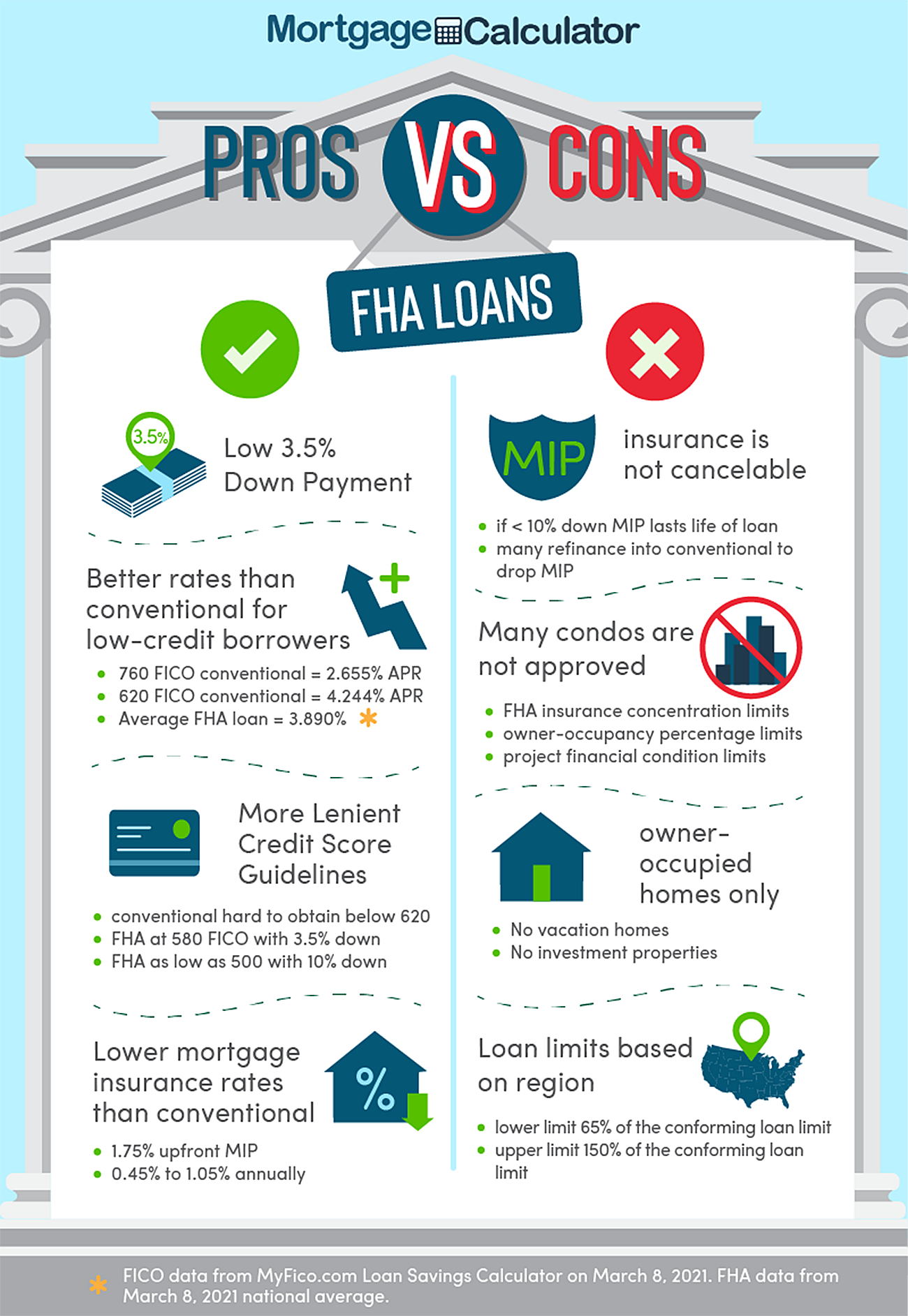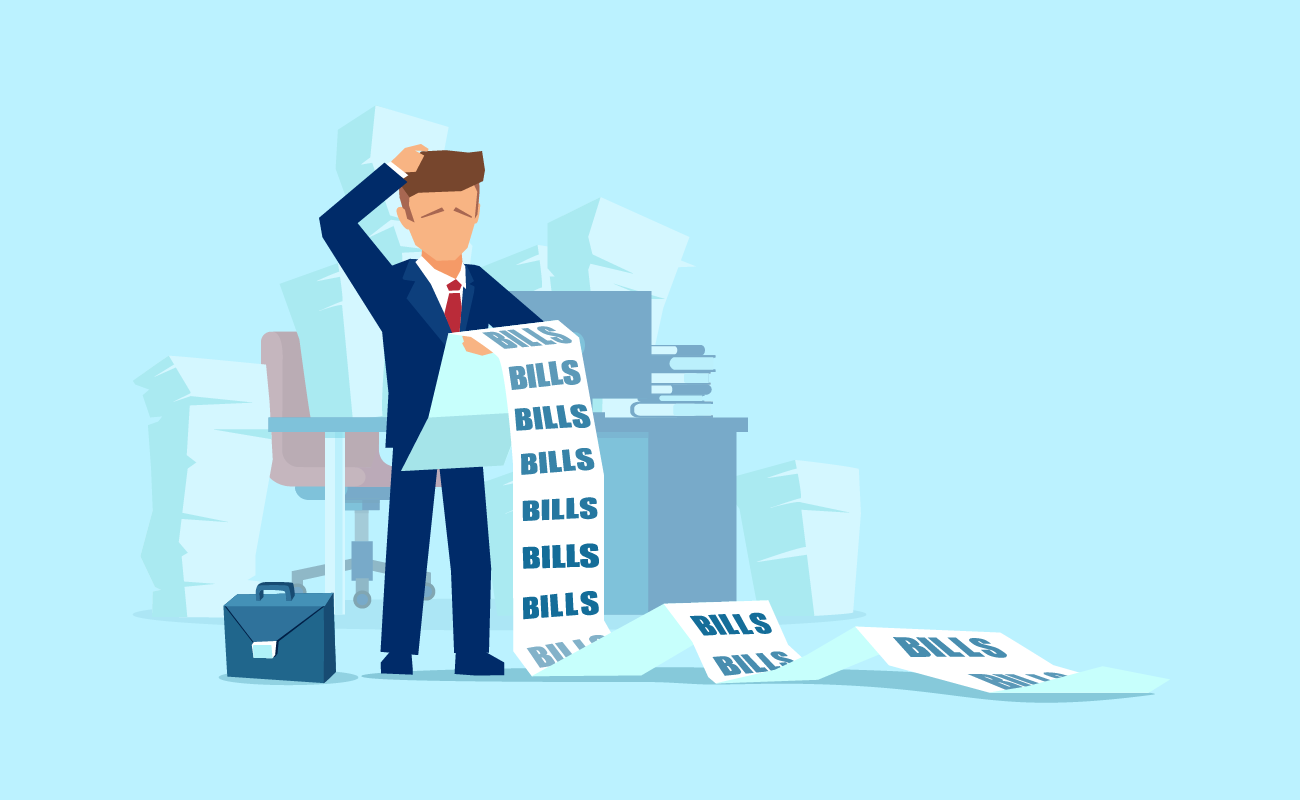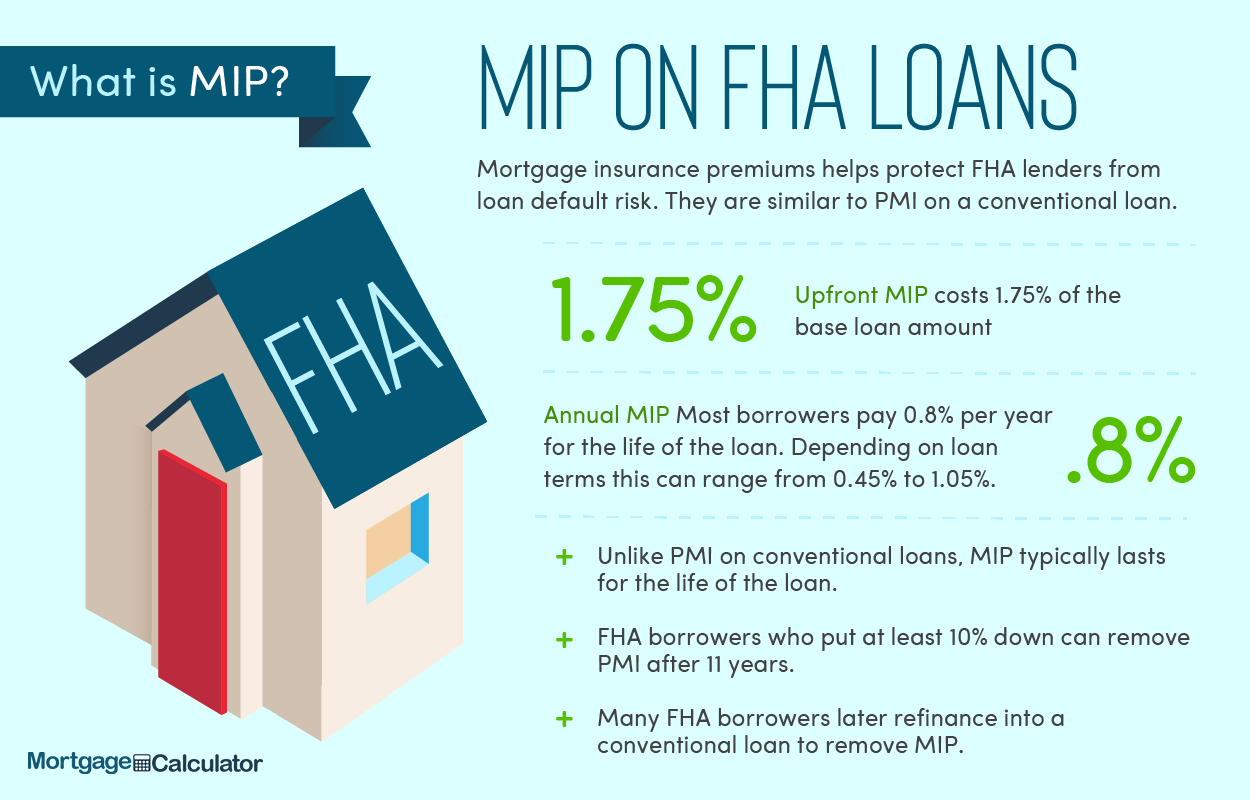
Here is a table listing current FHA home loan rates available in Columbus. You can use the menus to select other loan durations, alter the loan amount, or change your location.

In response to the Great Depression, the Federal Housing Administration (FHA) was created under the National Housing Act of 1934. Around 40 to 50% of U.S. homeowners defaulted on their mortgage by 1933. To alleviate the housing crisis, the government created the FHA to restore capital flows in the housing market.
Before the Great Depression, borrowers only received 50% to 60% home financing. Most home loans came with short 11 and 12-year terms and adjustable-rates. These required large balloon payments by the end of the term. When homeowners could not afford the large payment, they kept refinancing and extending their mortgage. Eventually, many homeowners could not sustain payments, which lead to widespread foreclosures.
With the creation of the FHA, rules were put in place to ensure better lending practices. Borrowers were insured at least 80% of the home’s price, as long as they prepared a 20% down payment. To help more Americans afford homes, the FHA recommended extended terms such as 30-year fixed-rate mortgages. Over the years, FHA regulations significantly improved liquidity of the U.S. housing market.
Towards 1965, the FHA became part of the U.S Department of Housing and Urban Development (HUD). The FHA has insured more than 40 million mortgages and counting since 1934.

Estimate Your FHA Loan Closing Costs & Monthly Payments in Advance
Use our FHA loan qualifier or quickly estimate your FHA loan closing costs.
The FHA program made home loans available to more homebuyers. This helped raise the economy out of depression. However, as economic growth boomed in the current century, lenders became overly confident with extending credit. They began servicing higher risk borrowers with conventional mortgages. Conventional mortgage programs even included 0% down payment options. These also offered mortgages with 40 to 50-year terms.
Meanwhile, FHA loans continued to require at least 3% down and the usual credit qualifications. FHA mortgage insurance premiums (MIP) and origination fees also made interest rates higher for applicants. This happened when the applicant had issues with their credit background. And because loans had a higher rate, more subprime borrowers gravitated towards conventional loans.
However, during the late 2000s subprime housing crisis, home prices suffered a massive decline. This occurred after the collapse of the housing bubble, which led to massive defaults and foreclosures. Properties could not retain their values, which left many homeowners with underwater mortgages. Since their mortgage balance was higher than their home’s price, even if they sold it, they couldn’t pay back their loan.
Unemployment increased and homeowners who had good credit in the past were unable to afford their homes. Thus, FHA loan applicants began to increase during this time. Because FHA loan qualifications are more forgiving with past credit problems, many low to moderate-income homebuyers began applying for FHA loans again.
After the late 2000’s housing crisis, 0% down conventional loans became virtually non-existent in the market. Today, only government-backed mortgages such as VA loans and USDA loans offer a zero-down option with 100% financing. Even then, these mortgage options come with specific requirements before you can obtain a zero-down loan.
At present, government-backed mortgages provide affordable financing with less than 20% down payment. In particular, FHA loan borrowers are insured up to 96.5% financing on a home’s value, with as low as 3.5% down. This is granted provided borrowers meet particular mortgage qualifications. The FHA mortgage program offers relaxed credit requirements and affordable closing costs to consumers.
FHA loans continue to make home ownership more accessible for lower and middle class families. It is meant to stimulate the economy and facilitate lending. This is done by federally insuring mortgages, so lenders have protections in case borrowers fail to repay their loan.

FHA Loans Chosen by Consumers in 2020
In 2020, approximately 16% of homebuyers reported securing an FHA loan to finance their home purchase. Meanwhile, 64% of homebuyers chose conventional loans, which is the most commonly purchased mortgage type in the U.S. Meanwhile, 14% were reported to obtain VA loans. These figures were based on the 2020 Profile of Home Buyers and Sellers report by the National Association of Realtors (NAR).
According to NAR, in 2020, 24% of first-time homebuyers sought FHA loans, more than repeat homebuyers at 11%. Repeat homebuyers usually took conventional loans at 69%, compared to 54% of first-time homebuyers.

How long do FHA borrowers pay MIP? Though the rules have changed over the years, the current rule states that borrowers who pay less than 10% down payment must pay MIP for the entire life of the loan. Meanwhile, if you pay at least 10% down, your MIP can be removed after 11 years.
To remove MIP, FHA borrowers can refinance into a conventional mortgage. Many borrowers use the FHA program as a steppingstone to homeownership. Once they’ve improved their credit score and built more equity in their homes, they refinance their mortgage into a conventional loan. This strategy allows borrowers to secure more favorable rates at better terms to boost their mortgage savings.
Is mortgage insurance premium (MIP) tax deductible? Tax deductions on MIP has been allowed and removed over the years. Since the IRS updates rules regularly, you might find mortgage insurance tax deductible in a particular year. For instance, since the financial crisis in 2020, homeowners were allowed to make tax deductions on mortgage insurance. You can check changes to the deductibility of MIP on the IRS website.
According to the IRS:
“P.L. 116-94, Division Q, Revenue Provisions, section 102, retroactively extends the applicability of section 163(h)(3)(E) for tax years 2018 and 2019, and through tax year 2020, to provide for the deductibility of mortgage insurance premiums (MIP). Use Form 1098, Mortgage Interest Statement, to report MIP aggregating $600 or more, that you received during the calendar year in the course of your trade or business from an individual, including a sole proprietor.”
Federally insured mortgages are generally less risky for lenders. This allows lenders to offer mortgages with relaxed credit standards and affordable closing costs. It’s the reason why FHA loans are attractive to first-time homebuyers and those with limited funds. Take note of the following benefits that make FHA mortgages more attractive to borrowers:

While FHA mortgages offer plenty of advantages, it also comes with several drawbacks. Consider the following disadvantages before taking this loan option:
Note that FHA mortgages come with a loan limit for borrowers. The floor limit is 65% of the current national conforming limit, while the upper limit or ceiling is 150% of the current national conforming loan limit.
FHA loan limits are categorized into different areas. Low-cost areas have lower limits called the floor. Meanwhile, high-cost areas have more expensive limits called the ceiling. The ceiling also includes special exception areas that have higher construction costs. These special exception areas are Hawaii, Guam, Alaska, and the U.S. Virgin Islands.
Although there have always been caps on FHA mortgages and FHA refinancing, over the years, ceilings for FHA mortgages have increased. The ceilings for FHA mortgages vary and are based on the size of the property and the median housing prices in each area.
In some high-cost areas, FHA mortgages are available for as much as $1,149,825 for a single-unit home as of 2024. If you are considering homes in more than one county, it makes sense to research the FHA mortgage lending caps in each county. The official HUD website offers a feature showing updated FHA loan limits for counties across the country.
As of 2024, the FHA floor limits for one-unit homes is $498,257, while the ceiling is $1,149,825. As for special exception areas, the loan limit is $1,724,725 for a one-unit home. For a detailed list of 2024 FHA loan limits, refer to the table below.
2024 FHA Loan Limits
| House Type | Floor | Ceiling | Special Exception Areas |
|---|---|---|---|
| 1-unit | $498,257 | $1,149,825 | $1,724,725 |
| 2-unit | $637,950 | $1,472,250 | $2,208,375 |
| 3-unit | $771,125 | $1,779,525 | $2,669,275 |
| 4-unit | $958,350 | $2,211,600 | $3,317,400 |
As mentioned, borrowers are required to pay MIP upfront as well as on an annual basis. These premiums are put in a special account that funds the entire FHA mortgage program. However, if defaults increase, the government steps in to make sure the funding remains sufficient.

In the late 2000s financial crisis, a large number of borrowers defaulted on their mortgage payments. Many homes went underwater, which meant the property’s value depreciated lower than the mortgage balance. To ensure adequate funding, the FHA imposed more stringent requirements.
Around 2010, the FHA increased the upfront MIP from 1.75% to 2.25%. Because defaults were prevalent, a higher MIP helped increase the funding. The increase covered the federal government’s default costs. They also raised the qualifying credit score to 580, while many lenders required higher FICO credit scores. Higher FICO ratings suggest a borrower is less likely to default on a mortgage. But today, the upfront MIP fee is back to 1.75%.
Moreover, lenders required larger down payments from borrowers with lower credit scores and higher debt-to-income ratio (DTI). A larger down payment reduces the size of the loan, which decreases the risk on lenders. In a growing economic environment, home sellers would normally fund up to 6% of closing costs. But in 2010, sellers were only able to fund up to 3% of the home’s price.
Over the last couple of years, FHA mortgages had higher default rates than conventional loans. This can be attributed to several factors:

Up until the early 1980s, the FHA set their own rate for mortgages. But after 1983, the Housing and Urban-Rural Recovery Act mandated that FHA mortgage rates should be market-based. Thus, FHA rates vary depending on the FHA-sponsored lender. Meanwhile, since conventional lenders tend to be more competitive, lenders typically offer lower conventional loan rates to borrowers.
Historically, FHA loan rates have usually been higher than conventional mortgage rates. Since 2000, FHA rates have been 0.125% to 0.25% higher that conventional loans. However, except for years following the late 2000s mortgage crisis (2010 to 2015), FHA mortgages had lower rates than conventional loans. Since Fannie Mae and Freddie Mac implemented loan level price adjustments and guarantee fees, FHA rates could be lower than conventional loans. But if the lender passes them on to the borrower, it results in a higher rate.
During the subprime loan boom between 2004 to 2007, very few borrowers took FHA loans. However, more people started taking FHA loans again after the subprime market collapsed in the late 2000s. Because of this, the FHA program was the only option subprime borrowers had. The FHA program helped mitigate the late 2000s housing crisis, which prevented more foreclosures.
Why are FHA rates usually higher than conventional loans? FHA loans come with lenient credit standards and affordable down payments for borrowers. They entail a lot of bureaucracy and special certifications for lenders. In this respect, despite federal protection for lenders, FHA loans are usually more costly for lenders.
The following table compares average FHA mortgage rates and conventional loan rates every three years, between 2000 to 2020.
| Year | Loan Volume | Average FHA Loan rate | Average Conventional Loan Rate |
|---|---|---|---|
| 2000 | 831,5472 | 8.38% | 8.26% |
| 2003 | 1,128,934 | 6.07% | 5.94% |
| 2006 | 399,905 | 6.53% | 6.50% |
| 2009 | 1,831,320 | 5.33% | 5.27% |
| 2012 | 1,184,498 | 3.65% | 3.85% |
| 2015 | 1,116,214 | 3.75% | 3.93% |
| 2018 | 1,014,609 | 4.78% | 4.54% |
| 2020 | 1,333,176 | 3.36% | 3.11% |
*Data from HUD, Mortgage Bankers Association, & Freddie Mac
Before taking any FHA mortgage, make sure to shop around for rates. Depending on your FHA-sponsored lender, your rate may be higher or lower than prevailing conventional rates. Some lenders may impose fees that can make conventional loans more competitive. Additionally, your financial background and credit score will influence the rate offered. If points and mortgage rates are the same, a conventional rate may often have a more competitive interest rate.

1
First-time homebuyers – The low 3.5% down payment is reason enough for many first-time buyers to take this option. Even if you’re not a first-time buyer, others with limited funds and resources for a down payment look into FHA loans. As a requirement, your credit score must be at least 580 to secure 3.5% down. If you have a small income and a relatively low credit score, you can also apply for an FHA loan.
2
Borrowers with a credit score of 500-579 – If you have poor credit, you have unlikely chances of obtaining a conventional loan. But if you apply for an FHA loan, you may still qualify for a mortgage. To secure your FHA loan, you must prepare a minimum 10% down payment.
3
Borrowers with past credit problems – Having a bankruptcy and foreclosure record makes it difficult to secure a conventional loan. You normally have to wait a much longer time to take out a mortgage (4 to 5 years after a chapter 7 bankruptcy). When you do get approved, you typically receive a higher rate. Some conventional lenders may even require a much higher down payment. However, with an FHA loan, you can obtain a mortgage within 2 years of being discharged of a chapter 7 bankruptcy. If you have a foreclosure record, you only need to wait 3 years, or one year if the foreclosed mortgage was an FHA-backed loan.
4
Older homeowners in need of a reverse mortgage – The FHA backs Home Equity Conversion Mortgages (HECM) for seniors 62 years old and above. HECM is a type of reverse mortgage that provides homeowners with a line of credit based on the equity of their home. The amount is also dependent on their life expectancy. HECM payouts help seniors sustain living expenses and cover medical bills to supplement their retirement.
Research various home loans and decide which program is most beneficial for your circumstances. Remember to shop around and get quotes from different lenders. All FHA mortgages do not have the same rates because individual lenders have discretion to incorporate their own fees. Although origination fees were once capped at 1%, lenders now have the discretion to set their own origination fees as long as they are reasonable.
Be sure to review your credit history. This gives you a better idea of your overall financial background. To get a copy of your credit report, visit AnnualCreditReport.com. Consumers are entitled to a free copy of their credit report every 12 months. Moreover, check it for errors, such as wrong recorded payments, address errors, or name corrections. Correcting credit information with your credit bureau will help improve your credit score.
Lenders also consider the following factors on your credit history:
Next, make a list of all your oustanding debts. Make sure to significantly reduce large credit card balances. Do not max out your credit cards and be sure to keep your balances low. It’s best to avoid making large credit card purchases or applying for expensive loans at least 6 months before your mortgage application. Finally, familiarize yourself with FHA mortgage requirements. Some of these requirements include the following:
Before applying for an FHA loan, be sure to organize all your documents. You will need to provide all your past addresses, your current and past employers’ names and locations, W-2 forms, and tax returns for the past two years. If you are a veteran, you will need to provide documentation pertaining to your discharge or DD Form 214. Your lender will give you the appropriate application form. You will also need to provide detailed financial information including bank statements, pay stubs, retirement benefits, and other information as needed.
Prepare the following documents for your FHA loan application:

Applicants can choose from a variety of FHA home loan programs:
The 203(b) loan is the basic mortgage program offered by the FHA. It applies to single-unit homes and multifamily housing. It also includes FHA approved condominium units and manufactured houses on real estate properties. The 203(b) FHA loan allows you to make a 3.5% down payment with a credit score of 580. It also allows you to obtain a mortgage with a credit score of 500 to 579 with a 10% down payment. The program accepts gifts as a down payment for your home. You can also finance the closing costs into your mortgage.
FHA loans also come in adjustable rate mortgages (ARM). FHA ARMs change based on the one year Treasury Bill index rate. This may rise no higher than 5% of the initial interest rate. Unlike a fixed-rate loan, your rate will change according to the prevailing index rates. This means that if rates rise, your monthly payment will increase. Before obtaining an adjustable rate, have the lender explain the index and research how rates were affected in past years. Though it’s easier to qualify for an adjustable-rate loan, this can get risky. You may have trouble making monthly payments when your rate resets higher. Adjustable-rate mortgages typically appeal to buyers who intend to move after a short term.
Under the FHA 203(k) mortgage program, you can finance your home purchase and renovation all in one loan. It can also be used for home improvements on your existing property. The borrower is required to submit detailed information about the nature of the work and cost estimates. This is ideal for homeowners purchasing an older home or a property in disrepair. Financing for repairs makes it easier for buyers to improve their purchase, which ultimately enhances housing in the community.
The FHA EEM program can be used by borrowers who have a current FHA loan. Under this program, you can make energy efficient improvements on your property to reduce operating costs. High electric and water bills can hinder a homeowner’s ability to pay their mortgage. In this respect, the EEM program was designed to help reduce your home’s utility costs. You can upgrade your insulation, improve your infrastructure, and have solar panels installed. There may also be tax benefits for certain energy efficient improvements.
Under section 245, the FHA provides a Graduated Payment Mortgage program (GPM). This home loan let’s you obtain affordable monthly payments that gradually increase over the life of the loan. You can set how your payment increases at various yearly increments. The FHA’s GPM program can be beneficial to borrowers who expect salary increases, inheritances, or other higher sources of income down the road. The program also allows you to prepay your mortgage faster over the years.
Borrowers who are at least 62 years old can qualify for Home Equity Conversion Mortgage (HECM). This is an FHA-insured reverse mortgage that allows you to receive monthly payouts or a revolving credit line based on your home equity. Qualified applicants do not need to pay the loan unless they sell the property. If they pass away, their heir pays for the loan using proceeds from the property’s sale.
The following are factors that determine the loan amount for a reverse mortgage:
Refinancing provides the opportunity to reduce your loan term, lower your monthly payments, and obtain a lower interest rate. You also have the option to cash out money to tap your home equity.
The following are different types of FHA mortgage refinancing:
A cash out refinance involves paying off the original loan and refinancing your mortgage for a larger amount. This requires sufficient equity in the home, which is at least 20%. Your equity can increase in two ways: When you’ve paid down a significant portion of your mortgage, when the value of your home has increased, or both.
FHA mortgages permit cash out refinancing if the house was purchased at least one year prior. Closing costs can also be rolled into the refinanced mortgage. Borrowers do not need an existing FHA mortgage to qualify for cash out refinancing. If you are considering an FHA cash out refi, be aware that the HUD announced a lower loan-to-value (LTV) limit. As of August 1, 2019, the LTV limit is now 80% on FHA cash out refinances (previously 85%).
To be eligible for an FHA streamline refinance, you must have an existing FHA loan. Your mortgage must also be current, which means you should have made at least 6 monthly payments. Your existing mortgage should be active for at least 210 days before you apply for streamline refinancing.
With FHA streamline refinance, note that your new loan cannot exceed the original loan amount you borrowed. It does not provide a cash out option, but allows you to obtain a more favorable rate and term. However, you can receive a cash excess of $500, provided that it’s not taken out on the refinanced mortgage. Moreover, as a precondition, the refinance must have a net tangible benefit to the borrower. Note that the definition of a net tangible benefit depends on the type of loan, as well as the interest and term of the new loan. In this respect, if the refinance allows you to make easier monthly payments, lenders cannot seek reimbursement from the FHA if you default on your loan. Finally, while these are the basic requirements, some lenders may request additional requirements when you apply for an FHA streamline refi.
Established in 2009, FHA Home Affordable Refinance Program (HARP) allowed homeowners to refinance their existing FHA loan and second mortgage into one loan. However, the HARP program ended in December 31, 2018.
Under this refinance option, homeowners could consolidate a non-FHA loan into an FHA refinance. To qualify, the second mortgage had to be more than 12 months old. The homeowner shouldn’t withdraw from the second mortgage within the last 12 months. If they were to take any funds, the money should have been used for home repairs or renovations. It also required an appraisal for your home to qualify for the loan. The closing costs were regulated and refinancing was available for 96.5% of the home's appraised value.
In the 10 years of HARP, an estimated 3,495,500 borrowers completed refinances through the program. This included many active loans still outstanding.

FHA loans are a viable mortgage for first-time homebuyers and borrowers with limited funds. It’s an attractive financing option if you’re looking for a mortgage with a low down payment and more forgiving credit requirements. You can qualify even with a credit score of 500, as long as you make a 10% down payment. But if your credit score is 580, you can take advantage of the 3.5% down payment.
Since lenders set the rates, remember to shop carefully for an FHA loan. Lenders may offer higher rates for FHA loans. Meanwhile, conventional mortgages may provide competitive rates, but expect stricter credit standards and higher down payment requirements. If you had past credit issues such as bankruptcy and foreclosure, it’s easier to obtain and FHA loan than a conventional mortgage. If you are purchasing a home that you expect to turnover in a few years, an FHA loan will be particularly attractive and easier to sell. This is because FHA loans are assumable mortgages, which are more convenient to obtain for buyers.
On the other hand, FHA mortgages come with drawbacks. Expect to pay upfront mortgage insurance premium (MIP) and an annual MIP. Because FHA mortgages are funded by these premiums, they often come with long-term MIP costs. If you pay 10% down, you can remove the annual MIP after 11 years. But if you pay 3.5% down, you’re required to pay MIP for the entire life of the loan. To avoid this expensive cost, FHA borrowers eventually refinance into a conventional loan. Refinancing helps homeowners obtain lower rates, which boosts their mortgage savings.
If you have limited income, consider taking an FHA mortgage. Overall, with the broad selection of FHA programs, it’s possible for low to moderate-income families to achieve their homeownership goals.
US 10-year Treasury rates have recently fallen to all-time record lows due to the spread of coronavirus driving a risk off sentiment, with other financial rates falling in tandem. Homeowners who buy or refinance at today's low rates may benefit from recent rate volatility.
Don't pay too much for your mortgage. Leverage our lender network to get a FHA loan at today's historically low mortgage rates.
Check your mortgage options with a trusted Columbus lender.
Answer a few questions below and connect with a lender who can help you lock-in a low rate FHA loan and save today!